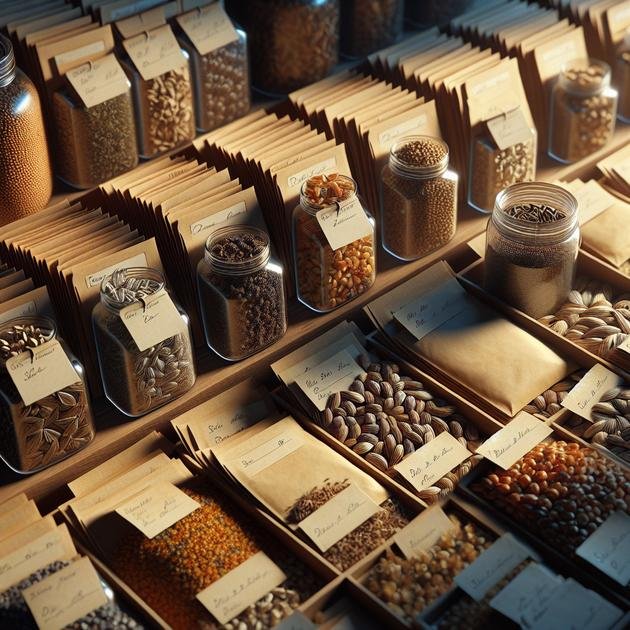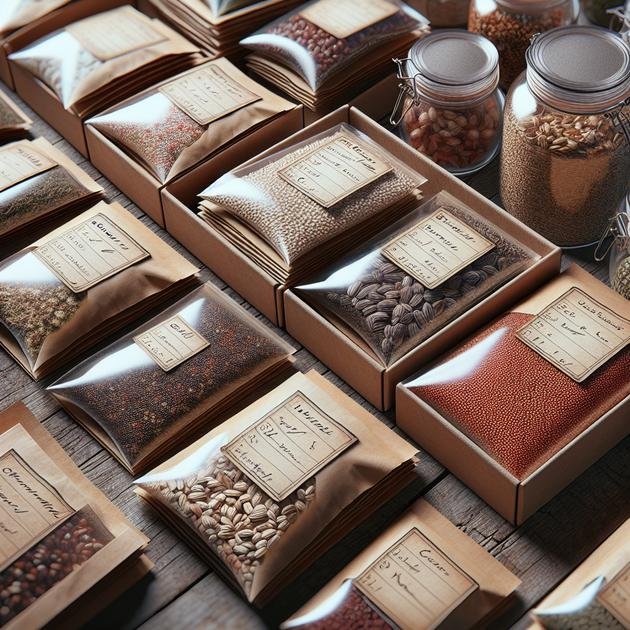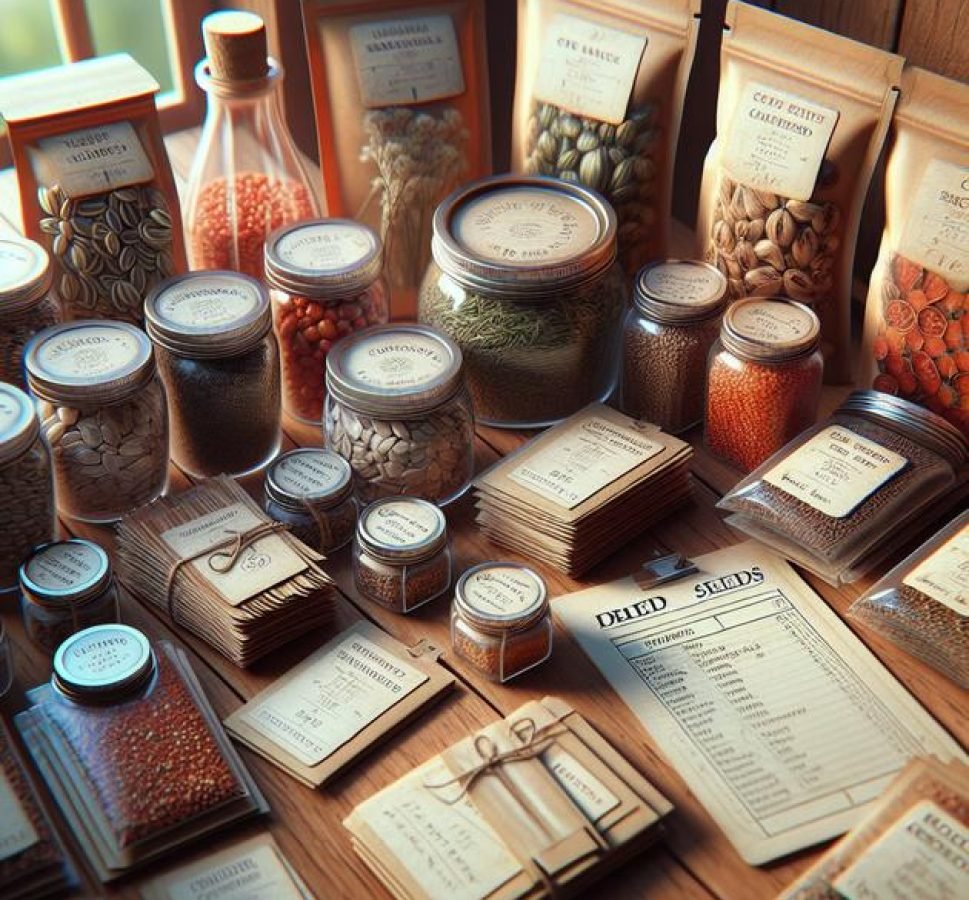Heirloom seed saving involves collecting, drying, storing, and sharing seeds from open-pollinated plants to preserve genetic diversity and maintain plant varieties for sustainable gardening.
Heirloom seed saving might seem like a complex hobby, but it’s actually a rewarding way to keep rare plant varieties alive. Ever thought about how saving seeds can impact your garden’s future? Let’s unpack the basics together and see how simple it can be to protect these treasures.
what are heirloom seeds and why save them
Heirloom seeds are seeds from plant varieties that have been passed down through generations, often for 50 years or more. They are open-pollinated, meaning they can reproduce true to type, unlike many hybrid seeds. These seeds carry unique flavors, colors, and history, making them special in your garden.
Saving heirloom seeds is about preserving biodiversity and cultural heritage. When you save seeds, you’re helping protect rare plants that might otherwise disappear from stores. It also gives you freedom to grow plants adapted to your local environment.
Many gardeners save heirloom seeds to save money and maintain self-sufficiency. Instead of buying new seeds every season, you can harvest your own from healthy plants. This practice supports sustainable gardening and encourages a closer connection to nature.
Why save heirloom seeds? Because it keeps precious plant varieties alive for future generations, promotes genetic diversity, and deepens your gardening experience. Plus, you get the joy of growing plants with rich histories and flavors that can’t be found in modern commercial seeds.
choosing the right plants for seed saving
When choosing the right plants for seed saving, focus on healthy, open-pollinated heirloom varieties. These types preserve the traits you want and ensure seeds can reproduce true to type. Avoid hybrids as their seeds often don’t grow into the same plant.
Pick plants that have performed well in your garden. Look for strong growth, disease resistance, and good fruit or flower production. Saving seeds from robust plants helps improve your garden over time.
Certain plants are easier to save seeds from, such as beans, peas, tomatoes, and lettuce. These typically have larger seeds and are straightforward to collect and store. Cross-pollination is an important factor; choose plants that don’t cross easily with others to keep seed lines pure.
Consider your climate too. Select plants adapted to your growing conditions for the best results. Saving seeds from well-suited plants ensures future crops thrive in your environment.
how to collect seeds properly

To collect seeds properly, start by waiting until the fruit or seed pods are fully mature. Timing is crucial because immature seeds may not germinate well. For many plants, this means letting seed pods dry on the plant before harvesting.
Use clean hands or scissors to gently remove seeds or pods without damaging the plant. For larger seeds like beans or peas, simply shell them out once dried. For smaller seeds, like lettuce or carrots, shake or rub the dried flower heads over a container to gather seeds.
Separating seeds from chaff is an important step. Tap or blow gently to remove lightweight debris, leaving behind the viable seeds. Make sure seeds are completely dry before storing to prevent mold.
Label your seeds with the plant name and collection date. Store them in a cool, dark, and dry place, ideally in paper envelopes or glass jars. Proper collection methods ensure the best seed quality for planting later.
drying and storing seeds for longevity
After collecting seeds, drying them properly is vital for long-term storage. Spread seeds in a single layer on a paper towel or mesh screen in a warm, dry area away from direct sunlight. Allow them to dry for 1 to 2 weeks until they feel crisp and break easily.
Moisture is the main enemy of seed longevity. To prevent mold and rot, make sure seeds are thoroughly dry before storing. Using silica gel packets or rice in storage containers can help absorb any remaining moisture.
Store seeds in airtight containers like glass jars or sealed envelopes. Keep these containers in a cool, dark, and dry place, such as a basement or refrigerator. Avoid places with fluctuating temperatures.
Label each container with the seed type and collection date. This helps track seed age and ensures you use older seeds first. Proper drying and storage can maintain seed viability for several years, preserving your heirloom varieties.
understanding seed viability and germination
Seed viability refers to a seed’s ability to germinate and grow into a healthy plant. Over time, seeds lose viability, so understanding how long different seeds remain viable is key for successful gardening. Some seeds, like tomatoes and lettuce, stay viable for 3 to 5 years, while others, like onions, may only last 1 year.
Germination is the process where a seed begins to grow into a seedling. To encourage germination, seeds need the right conditions: water, warmth, and sometimes light. Each plant species has its ideal environment for germination.
Testing seed viability
A simple test involves placing 10 seeds between moist paper towels, keeping them warm, and checking how many sprout in a week or two. If most sprout, your seeds are still good. If few or none germinate, it’s time to get fresh seeds.
Proper seed storage helps maintain viability and germination rates. Keep seeds dry, cool, and dark to slow aging and preserve their ability to grow strong plants.
common mistakes in seed saving to avoid

One of the most common mistakes in seed saving is harvesting seeds too early. Immature seeds often fail to germinate or produce weak seedlings. Always wait until seeds or pods are fully ripe and dry before collecting.
Another error is not drying seeds thoroughly. Moist seeds can develop mold or rot during storage, ruining your seed stash. Spread seeds out in a dry, well-ventilated area until completely crisp.
Mixing seeds from different varieties without labeling is a frequent problem. Without proper labels, you risk planting the wrong seeds or losing heirloom lines. Always label seeds clearly with the plant type and date harvested.
Cross-pollination can also cause trouble. Some plants easily cross with others nearby, resulting in hybrid seeds that won’t grow true to parent plants. Isolate similar plants or use physical barriers to prevent this.
Finally, improper storage conditions shorten seed lifespan. Avoid heat, moisture, and light by storing seeds in sealed containers kept in cool, dark places.
sharing and exchanging heirloom seeds
Sharing and exchanging heirloom seeds is a rewarding way to preserve plant diversity and connect with fellow gardeners. Seed swaps and community exchanges allow you to trade rare varieties and discover new favorites adapted to local growing conditions.
When sharing seeds, package them carefully in labeled envelopes or small containers. Include the plant name, variety, and any special growing tips to help recipients succeed.
Benefits of seed exchanging
It promotes biodiversity by spreading unique genetic material and supports sustainable gardening practices. You also build relationships with other gardeners and learn valuable seed-saving tips.
Many communities organize seed libraries or exchanges where you can drop off and pick up seeds freely. Participating in these groups helps keep heirloom varieties alive and accessible.
Always follow good seed-saving and handling practices to ensure seeds remain viable and healthy when shared. This care preserves the quality and integrity of heirloom seeds for future gardeners.
tips for starting your own seed library
Starting your own seed library is a wonderful way to promote seed saving and support local gardening communities. Begin by gathering a variety of heirloom seeds that are well-suited to your climate and soil.
Find a central, accessible location for your seed library, such as a community center, library, or garden club. Ensure the space is cool, dry, and secure to store seeds properly.
Organizing and managing your seed library
Label all seeds clearly with plant name, variety, and collection date. Create simple guidelines for borrowing and returning seeds to encourage participation and maintain seed quality.
Educate your community about the importance of seed saving through workshops, newsletters, or social media. Share tips on how to collect, save, and plant seeds successfully.
Partner with local gardeners and seed savers to increase your collection and build a network. Encourage sharing and exchanges to keep your seed library diverse and thriving.
Wrapping up your heirloom seed saving journey
Saving heirloom seeds is a simple yet powerful way to protect plant diversity and grow a thriving garden. By choosing the right plants, collecting and storing seeds properly, and sharing with others, you help preserve valuable varieties for years to come.
Starting your own seed library or joining seed exchanges can connect you with a community of gardeners who care about sustainability and heritage gardening. These small steps make a big difference in keeping heirloom seeds alive.
With patience and care, seed saving becomes a rewarding part of your gardening routine. Try it yourself and watch your garden—and those around you—blossom with history and life.





